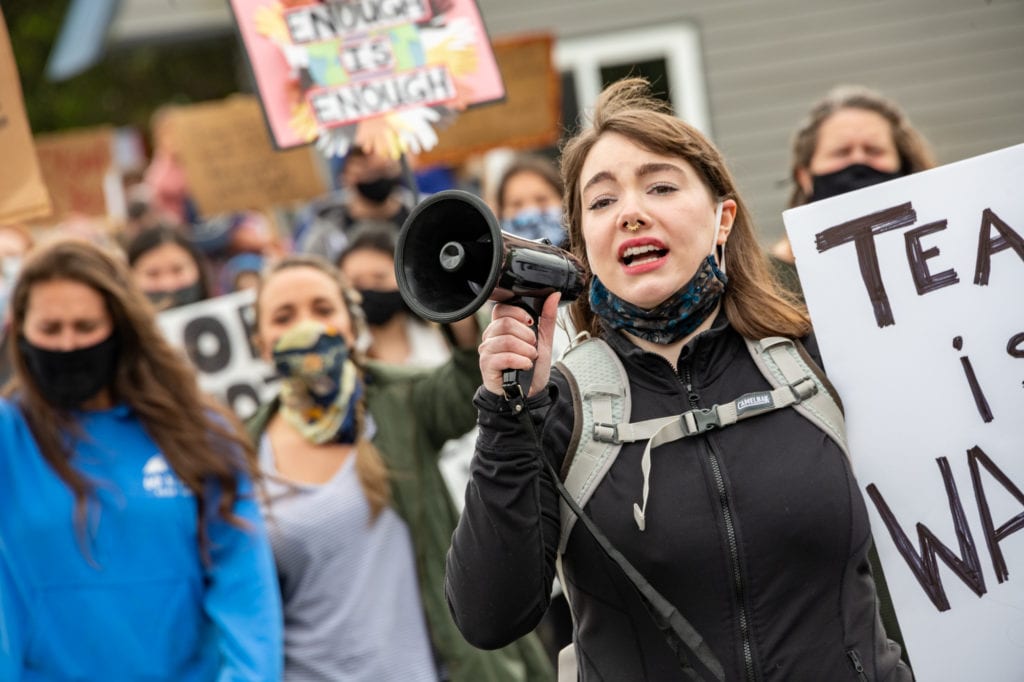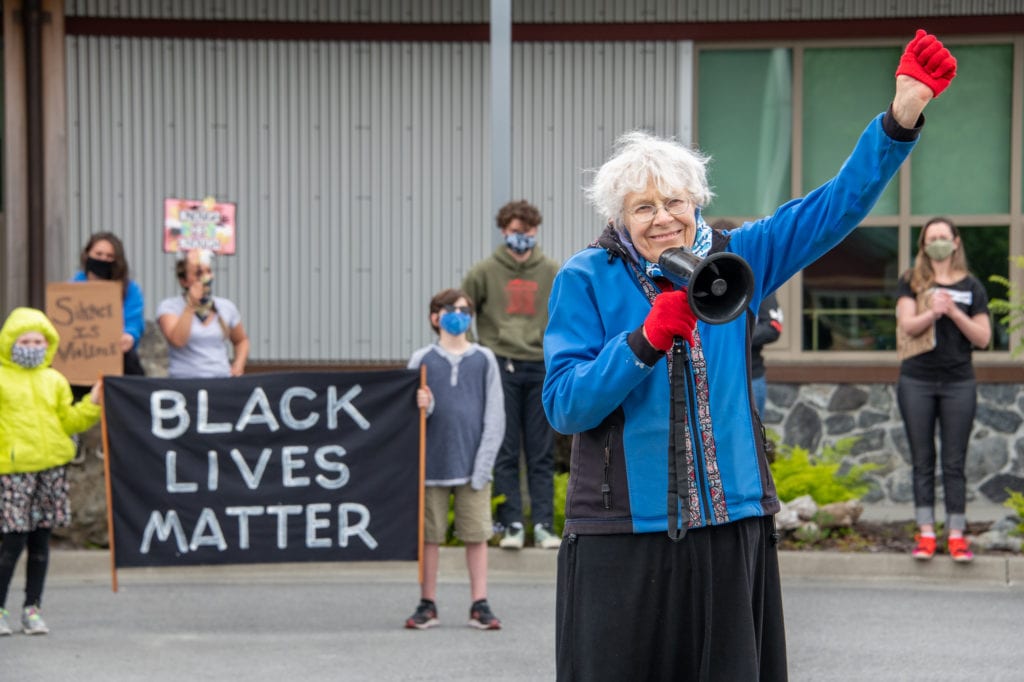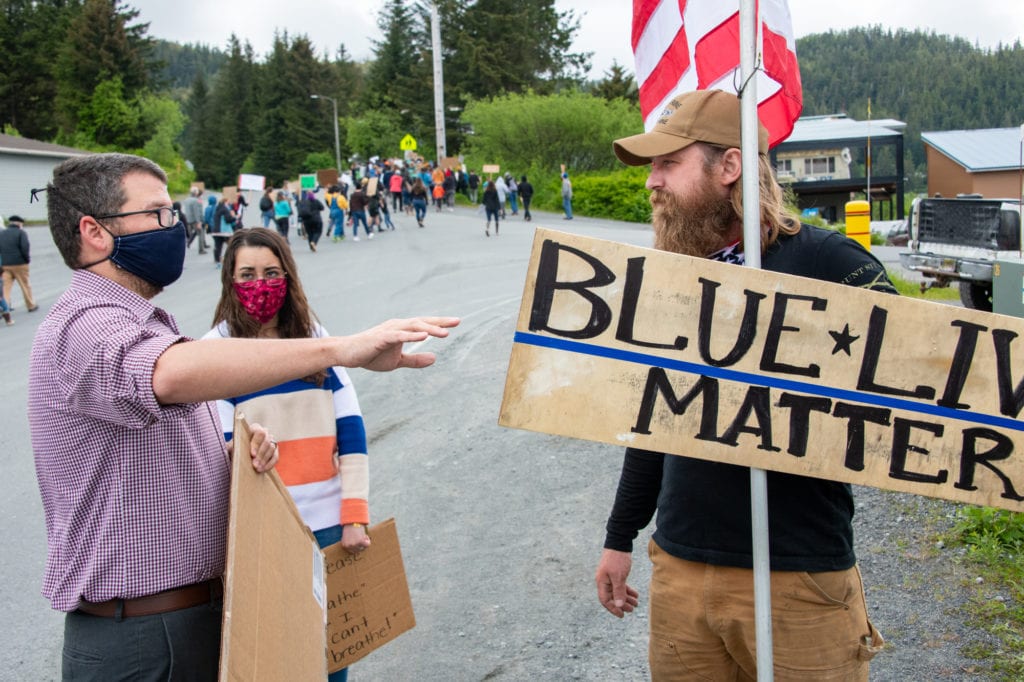
A Sunday, June 7 protest supporting the Black Lives Matter movement drew twice as many participants as a protest held the previous Sunday. The June 7 march and rally against racism and police violence drew 127 participants, organizers said.
Chanting the names of Breonna Taylor and Tony McDade, two black people fatally shot by police earlier this year, marchers proceeded down First Street and along Railroad Avenue, stopping at the Cordova Center. Some public officials, including Mayor Clay Koplin, joined the procession.
“I think that, whenever we see injustice, it’s something that we need to tackle individually and collectively, so I appreciate people putting effort into it,” Koplin said. “It’s a nice day to get together and do something positive as a community.”
Koplin did not attend the previous march, he said, because he was not aware of it. The May 31 march was announced just 18 hours ahead of time.
Black Lives Matter is a decentralized activist movement opposed to anti-black racism. Protests associated with the movement broke out across the U.S. following the death of George Floyd, a black man who was killed while being arrested by police in Minneapolis, Minn. on May 25. Officer Derek Chauvin, who knelt on Floyd’s neck while Floyd lay handcuffed on the ground, was charged with second-degree murder and second-degree manslaughter and held on a bail of up to $1.25 million. At the June 7 Cordova rally, protesters observed eight minutes, 46 seconds of silence, the length of time for which Chauvin was observed to kneel on Floyd’s neck.
Protests have been associated with looting and property destruction in cities like New York and Washington, D.C. However, demonstrations in Alaska have been uniformly peaceful, in some cases drawing endorsement from local police. In a June 3 announcement, the Alaska State Troopers and other state law enforcement bodies endorsed peaceful protests of Floyd’s death. Cordova’s May 31 Black Lives Matter march was also commended by Cordova Police and Fire Chief Mike Hicks, who said that the officers involved in Floyd’s death had broken the public trust.

Drawing broader concerns
Cordova’s May 31 Black Lives Matter protest was the first such event University of Oregon PhD Student Megan Butler had organized. Ahead of the June 7 protest, Butler consulted Zen priest Kelly Weaverling, Eyak Preservation Council Program Coordinator Skye Steritz and other community leaders to refine her approach. For Butler, balancing this crash course in community organizing with her university’s finals week was no small challenge.
“I think this is more important, right now, than my studies,” Butler said.
The June 7 protest broadened its focus beyond high-visibility incidents of police violence, with speakers addressing the crowd on topics like economic inequality and what they described as the U.S.’s failure to confront its racist history.
“This is America,” said the Rev. Belle Mickelson of St. George’s Episcopal Church, addressing the crowd. “Every single person should have enough food to eat. They should have a job. They should have housing and they should have lots of friends — like you guys! … I hope that in these coming weeks and months and years, we will do all in our power to spread the love around the world.”
Photography business owner Bree Mills also spoke, comparing the U.S. unfavorably to Germany, which, she said, has done a better job reckoning with its past. There remain numerous monuments to Confederate leaders in the U.S., Mills pointed out, while Germany does not allow monuments to Nazi leaders. In present-day Germany, hate crime laws have been used to suppress displays of Nazi symbolism and expressions of Holocaust denial, and students learn about the Nazi period in detail. By contrast, U.S. students are not educated about the real cruelty of American slavery, Mills contended.
“Germany is an imperfect country, but the average German knows and understands the details and the legacy of the mass murdering and persecution their forebears committed,” Mills said, wielding a bullhorn. “German schoolchildren visit the remains of the death camps. There are monuments to the murdered Jews of Europe across the country… In Germany, there are still racists and anti-Semitic people. That exists around the world. No society is immune. But expressing pro-Nazi views or denying the cruelty of their Nazi past is culturally unacceptable and, in some cases, illegal. And that means, as a general rule, society has been able to develop into a healthier and more just society.”
A voter registration table was set up by Nancy Bird, an information officer for the Cordova Legislative Information Office. Butler also encouraged rally participants to contact Sen. Lisa Murkowski, R-Alaska, Sen. Dan Sullivan, R-Alaska, and Rep. Don Young, R-Alaska, to voice their concerns.
The June 7 protest seemed more vigorous and better coordinated than the previous one, Butler said. However, despite her energetic organizing work, Butler feels that she herself presents a potential stumbling block for the movement.
“A big weakness of this movement here in Cordova — not broadly, but here in Cordova — is that it’s led by a white woman,” Butler said. “That’s a problem. It’s a problem that I take responsibility for. There needs to be more outreach for people of color in this community. There needs to be listening done and… white people like me just need to do better community-building work, to have conversations and engage with that community better. That is a problem, and that is something that can lead to a loss of energy, because white people are comfortable in this world and they can go back to their lives and remain comfortable.”

A dissenting voice
As Cordova’s Black Lives Matter protests grew, they also attracted their first counterprotester: fisherman Andrew Broders, who stood alone on Railroad Avenue with a sign reading “Blue Lives Matter.” Blue Lives Matter is a countermovement to Black Lives Matter that has worked to extend hate crime protections to police officers.
Broders said he didn’t disagree with protesters’ message of racial equality, but wanted to show support for police. Broders also expressed concern about violence and property destruction associated with protests elsewhere in the nation, drawing particular attention to the Lincoln Memorial in Washington, D.C., where walls were spray-painted with anti-police slogans.
“I understand what people are mad about,” Broders said. “There’s one or two cops out there that obviously crossed the line, beyond the pale — evil, as far as I’m concerned. And those people obviously should be punished, but it’s not everybody’s job. The reason I came out today is because of the things that have gone on in this country that have the Black Lives Matter logo attached to ‘em: vandalizing the Lincoln Memorial, et cetera, et cetera.”
While some passersby scoffed at Broders, others were simply curious what the phrase “Blue Lives Matter” meant. Protest participant Pastor Mike Glover, who spoke with Broders, said he was grateful that Broders had chosen to communicate his views respectfully.
“I had a little anxiety, a little bit,” Broders said. “But it’s been an absolute pleasure… Everybody was very nice, minus a few guys that drove by earlier.”
This modest backlash at least shows that Cordova’s Black Lives Matter demonstrations have made an impression, Butler said.
“Bring it on!” Butler said. “I’m louder than most people, and I think that this means that… it’s generating talk and conversation beyond just the circle of people who are interested already. It’s reaching the broader community.”





